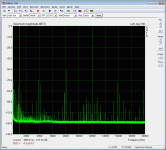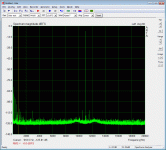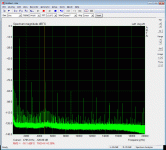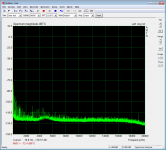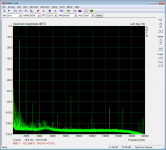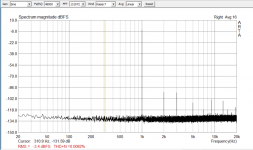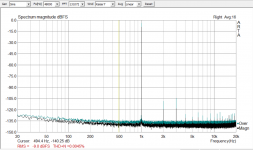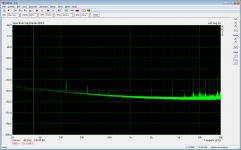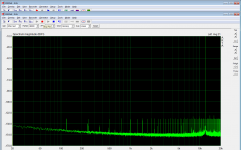You have some massive hum there! A lot of noise pickup. When you say, "The DAC is not wired perfectly, i.e. not all the wires are shielded," what does that mean?
I mean that the I2S and power wires are not shielded and the balanced bits are not shielded and not perfect twisted pairs.
I am beginning to think that the problem is that I am using a XLR to SE adapter then to the sound card. I should have an XLR to USB interface tomorrow and will see if that changes the distortion
I would think that noise pickup would be noise all over the spectrum. This is mostly on the harmonics.
I am beginning to think that the problem is that I am using a XLR to SE adapter then to the sound card. I should have an XLR to USB interface tomorrow and will see if that changes the distortion
I would think that noise pickup would be noise all over the spectrum. This is mostly on the harmonics.
Last edited:
Nice reference; thanks for the link. Doesn't seem to argue jitter measurement is a red herring, though, just that one needs also to know the DAC or SPDIF receiver's sensitivity. I understand the point you were making, though.you can get a much better understanding of the issue by reading Bob Adams's superbly clear article
Bob's conclusion was that what you needed to measure was the analog output, that distortion and noise were sufficient to characterize the effects of jitter.
Not quite. Output measurements indicate jitter sensitivity only if input jitter is controlled and measurements performed in such a way to as to remove other factors. This is the case in Adams' article but, as you've pointed out, most DIYers lack test equipment to generate a clock with specified jitter.
If one's simply interested in knowing overall performance the distinction's unimportant.
If one's simply interested in knowing overall performance the distinction's unimportant.
Vlad I don't know why you are getting such bad results, you shouldn't.
There was hum, but also a lot of distortion and noise. Attached below are 2 old M-Audio USB cards. Note how clean they are. One is 16 bit, the other 24 bit.
There was hum, but also a lot of distortion and noise. Attached below are 2 old M-Audio USB cards. Note how clean they are. One is 16 bit, the other 24 bit.
Attachments
You may have issues with sample rates not being congruent through out the software signal chain. If windows resamples anywhere it can cause havoc with any of your measurements.
You have the range 20-20KHz but the Fs is 96KHz, that means that the main is at the 45KHz.
Please, choose the Fs=48KHz, let the range at the 20-20KHz and then you will see the right.
Keep the Wnd=Hanning and the Avg=Exp or Linear.
Please, choose the Fs=48KHz, let the range at the 20-20KHz and then you will see the right.
Keep the Wnd=Hanning and the Avg=Exp or Linear.
Here is the j-test for one of my setups. Would you say there is no point in trying to reduce jitter on it?
In addition, the source signal must be a 16 bit, otherwise a 24 bit LSB toggle would be invisible (on the current DAC/ADC performance) 😀
Hp
Here is the 16 bit, 48 kHz J test
So what sound card did you use for this?
- Status
- Not open for further replies.
- Home
- Source & Line
- Digital Line Level
- Software for Measuring Jitter
